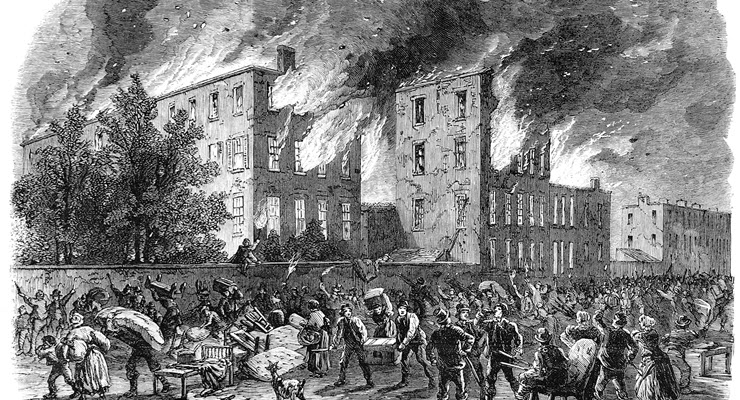Yesterday’s attempted coup is only the latest episode in a long history of violence and revolution in the United States.
After the storming of the US Capitol yesterday came the old refrain: “This is not who we are“.
The phrase isn’t just morally frivolous (just how many mass shootings or neo-Nazi rallies have required its deployment in the past four years alone?). It’s also factually incorrect.
While this is the first time a coup has been attempted at the behest of a president, it’s only the latest episode in America’s violent and revolutionary history.
New York City draft riots
The US managed the largest popular insurrection in its history right in the middle of its deadliest war (only in America, folks!).
The draft riots began on July 13, 1863 in New York, initially in response to the clear class-based inequities of a strict new conscription law.
Under the Civil War Military Draft Act, there were two ways to legally dodge the draft. You could hire a substitute to fight for you, or buy your way out for $300. Thousands of workers, largely Irish, poured into the streets to protest.
The demonstration quickly turned violent; the mob stormed the draft office and beat the police superintendent unconcious. But the riot was as much motivated by race as it was class — many of the rioters viewed free Blacks as competition for jobs and in some cases (stoked by Democrat politicians in the north) even blamed them for the war.






So when things turned violent, much of that violence was directed towards the Black community; during the four days of chaos, the mob turned on freed slaves, and beat to death and lynched Black men. A Black orphanage and church were burned down.
Bread riots
In April, 1863 a group of “armed, half-starved women” stormed the Virginia state Capitol, demanding to speak to governor John Letcher and sparking the bread riots.
The south’s supply lines had been choked off by a Union blockade, made worse by a snow storm that March. Indeed, the Virginia riot was just the largest of many in response to food deprivation across the southern states.
After an unsatisfactory response from Letcher, the women, armed with axes, knives, and other weapons, marched through the city, ransacking government warehouses for food. Their numbers swelling, they chanted “bread or blood”.
The riot finally ended after the public guard arrived and threatened to open fire on the crowd. Around 60 people were arrested, and the city installed artillery in key areas of the city as a warning against future uprisings.
Anti-reconstruction uprisings
In fact, there have been so many uprisings over the course of US history, we’ve had to skip quite a few (sorry to all you Nathaniel Bacon and John Brown fans out there).
Twice in late 1874, the White Man’s League (a white supremacist terrorist organisation formed out of the southern Democratic Party who operated openly and frequently sought out media coverage for its views) tried to interfere in elections in Alabama and Louisiana.
In Alabama it seized polling places and county offices, killed at least seven Black Republicans (at least 70 more were injured) and intimidated others away from voting or burned their ballots. It worked. Black voters stayed away from the polls and anti-reconstruction Democrats regained control of the state government.
This followed the three-day occupation of the Louisiana state house and armory by the league, as it attempted to overthrow the Republican government and reinstall John McEnery, a white supremacist who refused to concede his defeat in the gubernatorial election two years earlier.
While they eventually were forced to retreat, it ultimately worked, in effect bringing to an end to reconstruction policies in the state.
Wilmington coup
The last successful coup in the United States happened on November 10 1898 when white supremacists overthrew the city government of the majority Black city of Wilmington, North Carolina. It followed years of race-baiting from the Democrats, echoed and amplified by local partisan media.
The insurrection started with the mob burning down the office of Black-run newspaper The Daily Record, and would eventually result in the killing of an unknown number of Black residents.
The mayor, the alderman and the chief of police were forced to resign while prominent members of the Black community (along with unsympathetic whites) where expelled by threats or physical removal.
The mob went on to alter the law to disenfranchise Black voters for generations, dropping enrolment numbers from over a 100,000 to less than 10. No one was ever prosecuted.
A review of David Zucchino’s Wilmington’s Lie notes: “The plan was hatched in secret, but the conspirators were remarkably open about the coup once it began. A reporter from out of town marvelled, ‘what they did was done in broad daylight’.”




Fetch your first 12 weeks for $12
What a year. Here at Crikey, we saw a mighty surge in subscribers throughout 2020. Your support has been nothing short of amazing — we couldn’t have got through this year like no other without you, our readers.
If you haven’t joined us yet, fetch your first 12 weeks for $12 and start 2021 with the journalism you need to navigate whatever lies ahead.
Peter Fray
Editor-in-chief of Crikey








